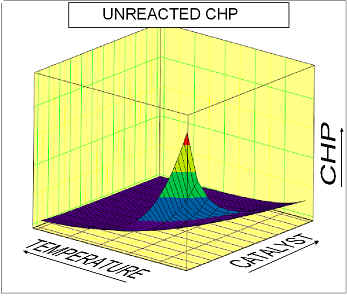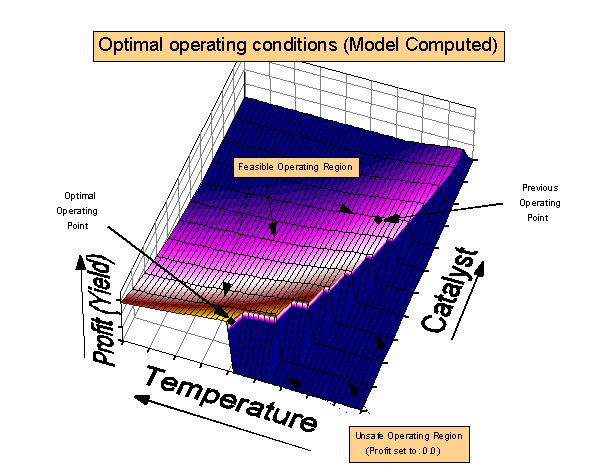|
| |

R2 Controls Completes major control projects at Sunoco
2nd major project improves yield
Jan2001 -- The recent project involves exothermic
reactors, reactor modeling, reactor analysis, and reactor instruments and
controls. This project comes on the heels of a previous reactor control
project that used a similar overall methodology. The reaction is basically
heat CHP (Cumene Hydroperoxide) with a little catalyst, and remove the heat as
fast as it is formed. The process is typical for a "Phenol Production
Plant" and the process technology is licensed for general use by UOP and
Sunoco. The overall process starts with Cumene reacting with oxygen to
form CHP. The CHP is decomposed to form the products Phenol, Acetone, and
AMS. This project involved the second reaction which is the decomposition
of CHP. A joint Invensys, Sunoco, and R2Controls paper is being
written on the most recent project and should be available soon.
 The
decomposition reactor was modeled with detailed kinetics. The reactor was built
as a "User Block" in Aspen plus flowsheet simulator. The model was
very useful to compute what the reactor would make for any conceivable reactor
operating condition. If you notice the 2 graphs shown here, you can see
some calculations made from the reactor models, including the optimal operating
point. To verify the model, the reactor was tested with a DOE (Design of
Experiment) type of test. This is a hard thing to do on an operating unit,
but the results were worth the effort. Prior to running these tests,
certain instrument and regulatory control improvements were made. Test results
showed the models were not in complete agreement with the plant tests, but they
were close, and the overall conclusions and optimal operating points computed
with the models were confirmed. This information was essential to
structure the control system, as we needed to specify which constraints would be
involved, and what direction the control system needed to go to drive the
operation to the most profitable operating point. The control system was
implemented using DMC+ multivariable control technology. The controls were
relatively simple as multivariable controllers go, involving 3 MV's (Manipulated
Variables) and 5 CV's (Controlled Variables). A dynamic simulation using
Cape Software, www.capesoftware.com
was used for control system testing and for operator training. By starting
with a detailed understanding of the process, making required instrumentation
and regulatory control improvements and finally implementing a relatively simple
multivariable controller, the process has never been operated better and is
destined for optimal operation in the future. An audit comparing before
and after operation shows a significant increase of yield in the most valuable
AMS product and greatly improved stability as evidenced by standard deviations
of important controlled variables. The
decomposition reactor was modeled with detailed kinetics. The reactor was built
as a "User Block" in Aspen plus flowsheet simulator. The model was
very useful to compute what the reactor would make for any conceivable reactor
operating condition. If you notice the 2 graphs shown here, you can see
some calculations made from the reactor models, including the optimal operating
point. To verify the model, the reactor was tested with a DOE (Design of
Experiment) type of test. This is a hard thing to do on an operating unit,
but the results were worth the effort. Prior to running these tests,
certain instrument and regulatory control improvements were made. Test results
showed the models were not in complete agreement with the plant tests, but they
were close, and the overall conclusions and optimal operating points computed
with the models were confirmed. This information was essential to
structure the control system, as we needed to specify which constraints would be
involved, and what direction the control system needed to go to drive the
operation to the most profitable operating point. The control system was
implemented using DMC+ multivariable control technology. The controls were
relatively simple as multivariable controllers go, involving 3 MV's (Manipulated
Variables) and 5 CV's (Controlled Variables). A dynamic simulation using
Cape Software, www.capesoftware.com
was used for control system testing and for operator training. By starting
with a detailed understanding of the process, making required instrumentation
and regulatory control improvements and finally implementing a relatively simple
multivariable controller, the process has never been operated better and is
destined for optimal operation in the future. An audit comparing before
and after operation shows a significant increase of yield in the most valuable
AMS product and greatly improved stability as evidenced by standard deviations
of important controlled variables.


For More Information Contact:
www.sunocochem.com
or
R2 Controls
128 Mountain Road, Princeton, MA 01541
Tel: 508-369-5186 cell phone
FAX: None - Please use E-Mail
Internet: rys@R2Controls.com
|
